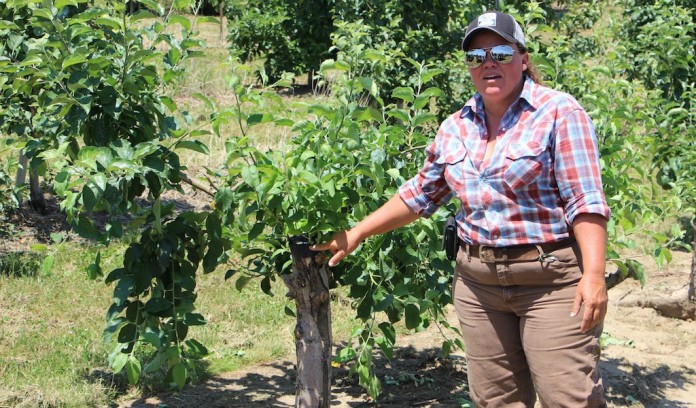
BERLIN HEIGHTS, Ohio — Sharing new ideas and technologies to help other fruit and produce growers successful was the goal of the 2016 summer tour of the Ohio Produce Growers and Marketers Association. Around 100 produce and fruit growers and Extension specialists visited Quarry Hill Orchards, in Erie County, June 22, to see how the Gammie family has incorporated new technologies and practices into their operation.
Orchard history
Bill Gammie and his wife, Jacque, are the second generation to carry on the traditions of the family orchard. “My father and brother started the farm (in 1931) as a vegetable farm,” said Bill. “And they just happened to plant a few apple trees on the property.”
Bill’s father died of cancer in 1964 and Bill didn’t immediately find his calling on the family orchard; going off to attend college, being drafted in the Vietnam War and coming back to be a school teacher. The land lease, still owned by Bill’s mother, was coming up for renewal and Bill decided he was ready to take on the farm in the late 1970s.
“We had to start over again,” said Bill, noting the few remaining apple trees had died. “But we had the land.” Bill’s son, Ben, didn’t immediately take interest in the family operation either, choosing a career away from the farm, but returning with his wife in 2013. “(Ben) and his wife, Brooke, are both passionate about farming,” said Bill, and they have helped take the farm to the next level by implementing new ideas and technologies into the orchard practices.
New farm practices
Last year, the Gammies planted 8,000 new trees and this year are planting 6,000 more, said Brooke Gammie. The larger volume of trees planted is part of a newer orchard practice called high density planting. “It’s truly an effort to make the orchard more efficient.”
Bill Baschke, farm manager for Glen Hill Orchards LLC, in Mount Vernon, said this is the direction the owners of the orchard he manages would like to move to. Traditional orchards planted around 400-700 trees, but the high density planting looks at planting 1,000-1,200 trees in an area, explained Baschke. “It creates more volume with less time to maintain each tree, cutting labor costs,” he said.
Ben Gammie explained a trellis system was set up in 1,000-foot rows, with trees planted at a spacing of 3 feet and 13 feet between each row. The goal of a high density orchard is to have fruit bearing trees by within two to three years of planting, which is achieved by using a dwarfing variety, according to North Carolina State University Cooperative Extension.
Dwarf trees also make it easier to maintain a smaller size and adopt practices of minimal pruning and simplified training, which is a key step toward labor efficiency, according to Penn State University Extension research.
Top-working
More recently, the Gammies have been experimenting with grafting by using existing tree rootstock, or top-working. Becky Colon, an employee who has been working closely with Quarry Hill’s fruit trees for five years, said she was pretty skeptical of the top-working method.
Having some less-than-desirable trees on the farm that weren’t producing anymore, the Gammies cut them down to base of around 3 feet. They cut all brush and limbs away from the stump base except for a couple nurse limbs left on each.
Grafting at Quarry Hill Orchards
During a tour of Quarry Hill Orchards, in Erie County, June 22, part of the OPGMA summer tour, attendees learned how the Gammie family tried out new grafting techniques using existing tree rootstock. (Catie Noyes photos)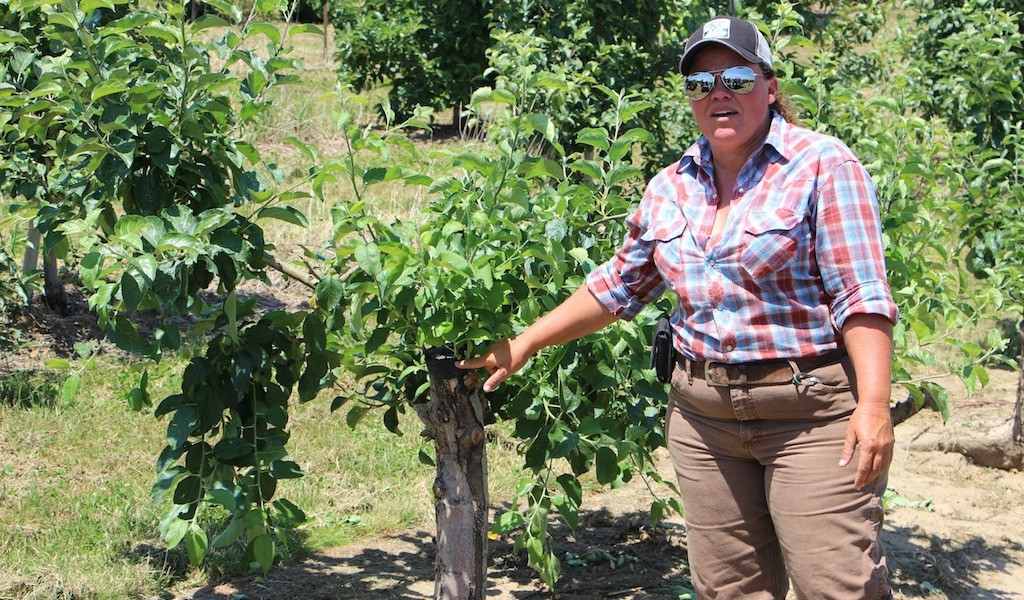
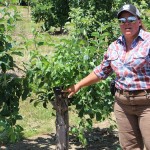 View
View
Grafting at Quarry Hill Orchards
During a tour of Quarry Hill Orchards, in Erie County, June 22, part of the OPGMA summer tour, attendees learned how the Gammie family tried out new grafting techniques using existing tree rootstock. (Catie Noyes photos)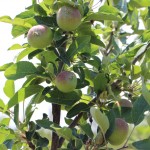 View
View
Quarry Hill Orchard apples
Gala and EverCrisp apples planted in dwarf varieties in 2015 and 2016, are starting produce a crop in the Gammie's high-density planting program.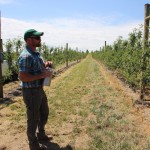 View
View
Ben Gammie explains trellis system
Ben Gammie explains how the trellis system works in his high-density apple tree block at Quarry Hill Orchards.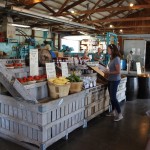 View
View
Quarry Hill Farm Market
While visiting Quarry Hill Orchards during the OPGMA summer tour, attendees had a chance to visit the Quarry Hill farm market and sample fresh picked cherries and other produce.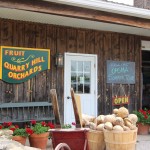 View
View
Quarry Hill Orchards welcomes tour goers
Quarry Hill Orchards, in Berlin Heights, Ohio, was the setting for the 2016 OPGMA summer tour, June 22. Producers from around the state were able to see how the Gammie family manages their orchard.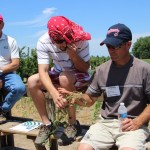 View
View
Inspecting cover crops
During one stop of the Quarry Hill Orchards tour, attendees saw how the Gammie family is starting to incorporate cover crops into it's program.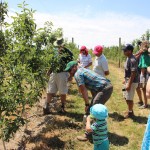 View
View
Always room for learning
Ben Gammie takes a moment to hear from a nursery expert who provided some of the trees for Quarry Hill Orchards. View
View
OPGMA vendors
Vendors shared insights on the latest tools and technologies fruit and produce growers can use in their operations. View
View
OPGMA vendors
15 vendors attended the OPGMA summer tour at Quarry Hill Orchards, to share the latest technologies with growers from across the state.Taking scion wood from existing trees on the farm, Goldrush scions were grafted into the existing stumps or rootstock. Colon explained. Electrical tape was wrapped around the grafted wood to hold everything in place and then top coated with tree coat.
“I’m thinking ‘this isn’t going to work’…I had no hope in what was going on,” said Colon, until she walked the orchard later to discover they “were budding out all over the place.” She said their rate of success hasn’t been 100 percent, but she said of the five or six graftings put on each rootstock, “at least four or five took and maybe one of them didn’t take.”
Now that Colon has seen what the top-working can do, she is ready to do more: “if I could go graft some trees all day, every day, I would.”
Something for everyone
Along with seeing the new techniques and ideas from the Quarry Hill Orchard, the tour provided an opportunity for producers to share ideas from their own operations.
Bob Sage, of Sage’s Apples in Chardon, said he and his family are good friends of the Gammies and came out to see how the they constructed their trellis system and to find out which varieties are doing well at the Quarry Hill Orchard. “Apples are the backbone of our operation,” said Sage.
Steve Haslinger, of Haslinger Orchards, in Sandusky County, said he was told by a friend, “if you learn just one thing you can take back to your operation to improve it, your visit was worth it.” Haslinger said he lost a block of his Gala apple crop this year and was unsure of the cause. Another producer told him because Gala apples are so delicate and valuable, it’s important to thin them by hand. He said that is something he will take back and try in his orchards in the future.











Now if only they would grow Organic, Without all the pesticides, and chemicals.